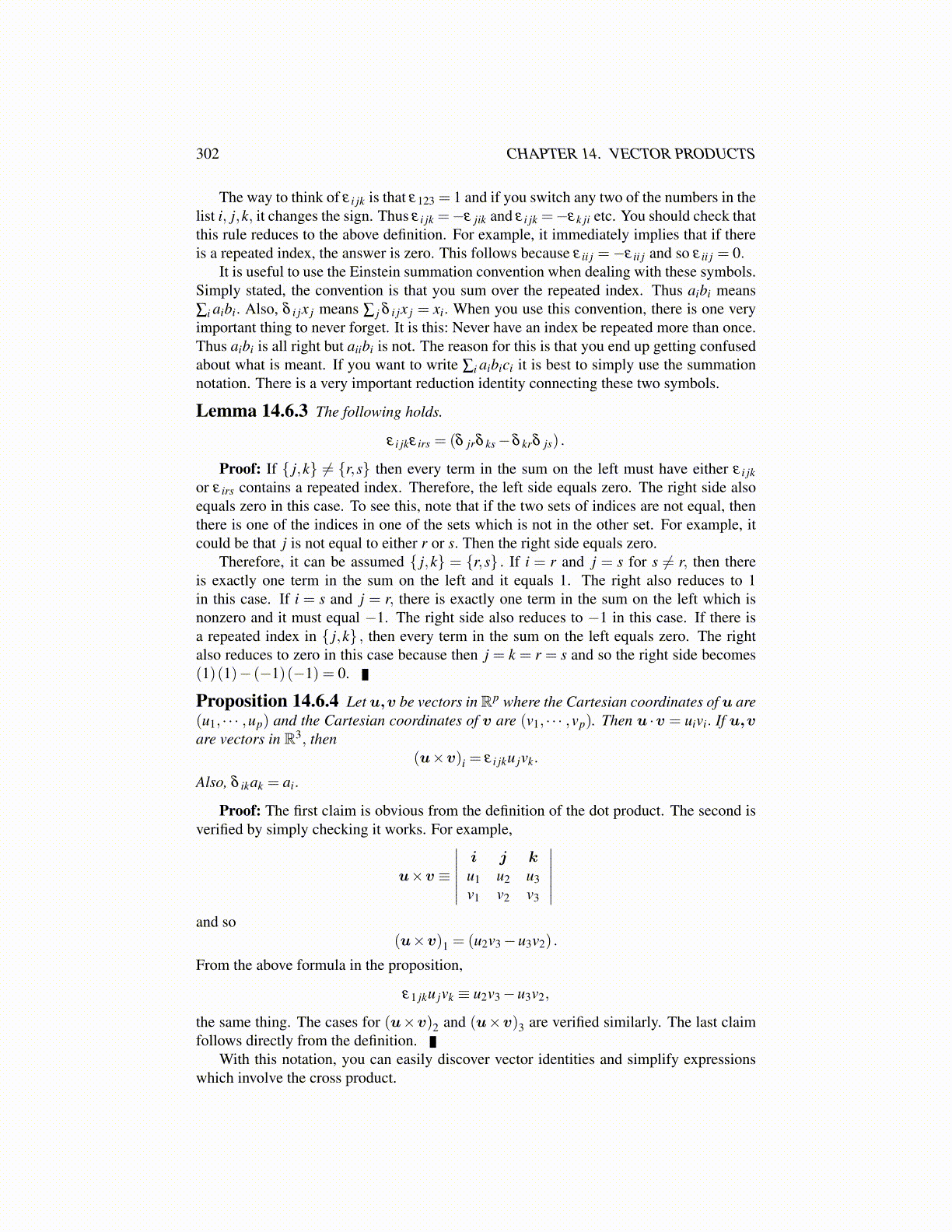
302 CHAPTER 14. VECTOR PRODUCTS
Definition 14.6.2 For i, j, and k integers in the set, {1,2,3} , ε i jk is defined asfollows.
ε i jk ≡
1 if (i, j,k) = (1,2,3) ,(2,3,1) , or (3,1,2)−1 if (i, j,k) = (2,1,3) ,(1,3,2) , or (3,2,1)0 if there are any repeated integers
.
The subscripts i jk and i j in the above are called indices. A single one is called an index.This symbol ε i jk is also called the permutation symbol.
The way to think of ε i jk is that ε123 = 1 and if you switch any two of the numbers in thelist i, j,k, it changes the sign. Thus ε i jk =−ε jik and ε i jk =−εk ji etc. You should check thatthis rule reduces to the above definition. For example, it immediately implies that if thereis a repeated index, the answer is zero. This follows because ε ii j =−ε ii j and so ε ii j = 0.
It is useful to use the Einstein summation convention when dealing with these symbols.Simply stated, the convention is that you sum over the repeated index. Thus aibi means∑i aibi. Also, δ i jx j means ∑ j δ i jx j = xi. When you use this convention, there is one veryimportant thing to never forget. It is this: Never have an index be repeated more than once.Thus aibi is all right but aiibi is not. The reason for this is that you end up getting confusedabout what is meant. If you want to write ∑i aibici it is best to simply use the summationnotation. There is a very important reduction identity connecting these two symbols.
Lemma 14.6.3 The following holds.
ε i jkε irs = (δ jrδ ks −δ krδ js) .
Proof: If { j,k} ̸= {r,s} then every term in the sum on the left must have either ε i jkor ε irs contains a repeated index. Therefore, the left side equals zero. The right side alsoequals zero in this case. To see this, note that if the two sets of indices are not equal, thenthere is one of the indices in one of the sets which is not in the other set. For example, itcould be that j is not equal to either r or s. Then the right side equals zero.
Therefore, it can be assumed { j,k} = {r,s} . If i = r and j = s for s ̸= r, then thereis exactly one term in the sum on the left and it equals 1. The right also reduces to 1in this case. If i = s and j = r, there is exactly one term in the sum on the left which isnonzero and it must equal −1. The right side also reduces to −1 in this case. If there isa repeated index in { j,k} , then every term in the sum on the left equals zero. The rightalso reduces to zero in this case because then j = k = r = s and so the right side becomes(1)(1)− (−1)(−1) = 0.
Proposition 14.6.4 Let u,v be vectors in Rp where the Cartesian coordinates of u are(u1, · · · ,up) and the Cartesian coordinates of v are (v1, · · · ,vp). Then u ·v = uivi. If u,vare vectors in R3, then
(u×v)i = ε i jku jvk.
Also, δ ikak = ai.
Proof: The first claim is obvious from the definition of the dot product. The second isverified by simply checking it works. For example,
u×v ≡
∣∣∣∣∣∣i j k
u1 u2 u3v1 v2 v3
∣∣∣∣∣∣